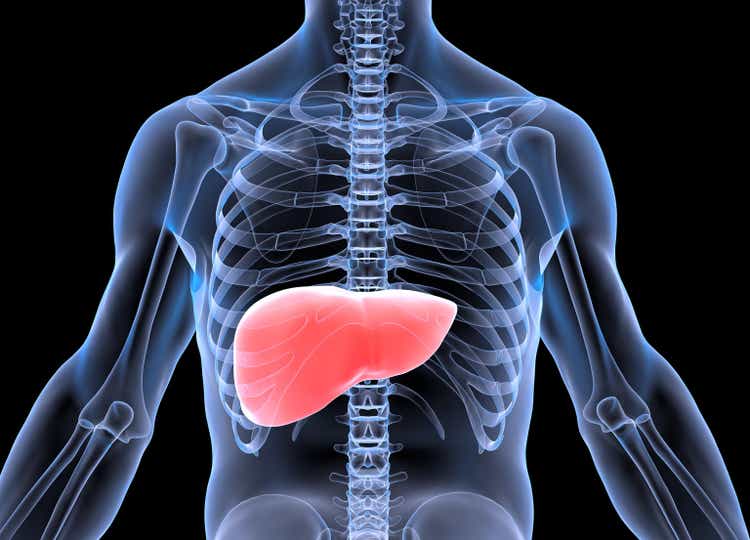Benito Vega
I covered 89bio (NASDAQ:ETNB) in early 2021, and the stock is down 75% since then, which gives me a reason to take another look at this company.
ETNB is a NASH drug developer. FGF21 analogue BIO89-100 or Pegozafermin is the lead and only molecule. The company is a “a 2018 spinoff of a few NASH assets, notably BIO89-100, originally held by Teva, with a $60mn financing led by Orbimed, the leading biopharma fund.” Last time, when I covered it, they had good early stage phase 1 proof of concept data from the molecule in NASH. In a set of around 91 patients, the molecule showed strong liver fat reduction and was generally well-tolerated. Additional data revealed in March showed that “BIO89-100 at 13 weeks has led to reductions in the liver volume of up to 15% and liver fat volume of up to 65% in patients compared to baseline.”
Just this year, in June, the company reported that a phase 2 trial in severe hypertriglyceridemia met its primary endpoint. Severe hypertriglyceridemia or SHTG is the company’s second indication, and unlike NASH, it is somewhat overlooked. Key data:
- Trial met primary endpoint demonstrating statistically significant and clinically meaningful reductions across all doses (63% at the 27mg QW dose; p<0.001) in triglycerides (TG) from baseline; results were consistent in patients on or not on background therapy –
– Observed significant and potent reductions in atherogenic lipids (non-HDL-C and apo B), liver fat, and improvements in liver enzymes and glycemic control markers –
– ENTRIGUE results support 89bio’s transition to a late-stage development company; Phase 3 expected to initiate in first half of 2023 –
According to Deepak L. Bhatt, MD, MPH, Executive Director of Interventional Cardiovascular Programs, Brigham and Women’s Hospital Heart & Vascular Center, Professor of Medicine, Harvard Medical School:
There is a critical need for SHTG treatment options that not only reduce triglycerides but also address broader cardiometabolic risks including hepatic steatosis and improve insulin sensitivity. Treatment with pegozafermin demonstrated impressive triglyceride reduction coupled with meaningful reductions in non-HDL-C and improvements in cardiometabolic parameters. Taken together, pegozafermin’s profile in ENTRIGUE shows great potential to uniquely address the key needs for patients with SHTG.
On this news, the company tried to raise $75mn ($94mn) in a secondary offering, and the stock dropped on that news. There was some minor safety concern with the trial, especially with the 27mg/week dose. There were two discontinuations in the trial, and both came from this cohort. One patient discontinued due to abdominal cramps, and the other due to nausea and vomiting. Overall, 22% and 17% of patients in this dose group experienced nausea and diarrhea respectively.
The company’s most important catalyst ahead is topline data from the ENLIVEN trial in NASH. Just last week, the company announced completion of enrollment of the 219-patient trial. ENLIVEN is a placebo-controlled Phase 2b trial in biopsy-confirmed NASH patients with fibrosis stage 2 or 3. The trial will topline in early 2023. With positive earlier stage data in the same indication, a number of analysts expect a positive outcome from this trial.
However, NASH is the graveyard of a number of biotech companies and failed programs. Indeed, FGF21, the pathway that ETNB targets, has seen a number of failures, the most notable being Bristol-Myers Squibb’s (BMY) pegbelfermin. Besides ETNB, Akero Therapeutics (AKRO) is another NASH player with a competing FGF21 molecule. While Akero is slightly ahead in development, it is also twice the market cap.
Financials
ETNB has a market cap of $194mn and a cash reserve of $139mn. R&D expenses were $19.7 million for the three months ended June 30, 2022, while G&A expenses were $5.1 million. That gives them about 6-7 quarters of cash.
Bottomline
ETNB is at a very exciting stage in their development, however the market seems not to notice. They just posted strong data in SHTG, a market which some analysts estimate is near $500mn for Pegozafermin. They had good POC data in NASH, and further data will appear next year. However, investors are wary of the NASH field, where many companies have gone to die; and without NASH, just the SHTG indication isn’t good enough. That may be the main reason the stock remains depressed. I look forward to 2023, when the NASH trial data may change all that.
About the TPT service
Thanks for reading. At the Total Pharma Tracker, we offer the following:-

Our Android app and website feature a set of tools for DIY investors, including a work-in-progress software where you can enter any ticker and get extensive curated research material.
For investors requiring hands-on support, our in-house experts go through our tools and find the best investible stocks, complete with buy/sell strategies and alerts.
Sign up now for our free trial, request access to our tools, and find out, at no cost to you, what we can do for you.



Be the first to comment